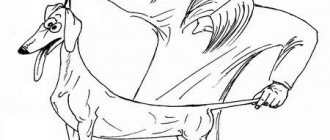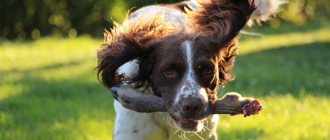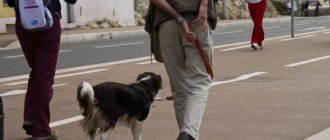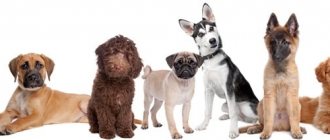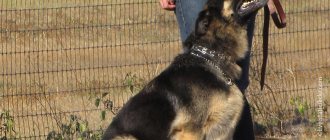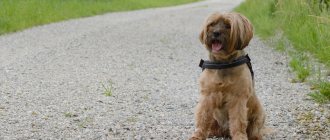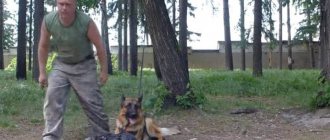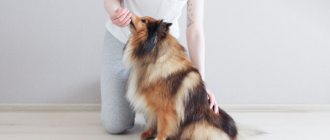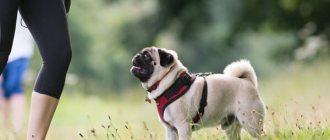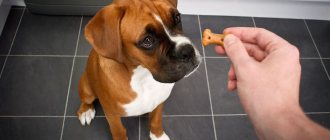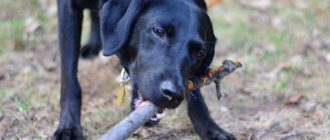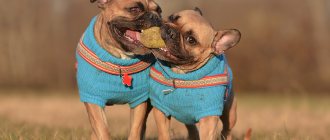Today we will talk about how to teach a dog the “Stay” command. This command is normative and is also often used in everyday life. For example, when you need to put a jumpsuit on a dog or brush it, it is much easier if it stands up straight and does not fall over.
Usually, teaching the “Stand” command begins at the age of 7 months, after the puppy has learned the commands “Sit”, “Lie down” and begins to behave more restrained.
Just like “Sit” and “Lie down,” the “Stand” command is practiced using a contrasting method, that is, it is equally important to use both coercion and encouragement. Coercion is pushing the dog under the stomach, and encouragement is praise and treats.
Some dog trainers advise introducing the dog to the “Stay” command during examination or brushing, but it is better not to do this. Many dogs, especially long-haired ones, do not get any pleasure from these procedures. Due to the unpleasant sensations that follow the “Stay” command, it will be more difficult for you to train your dog. So it’s better to train your puppy to stand separately from the examination.
Stages of training
Dog training is not an easy task and requires a lot of time and patience. In the process, you need to move gradually from simple to complex, from undebugged execution to accurate and trouble-free execution. To begin with, the dog must understand what is required of it (in this case, the command to Stand), and in this it needs help. Every correct action of the dog must be rewarded in order to form a positive reinforcement. This is very important at this stage of training. Wrong or erroneous actions should not be encouraged.
- The first stage is at the very beginning of training, the dog may be distracted by strangers, surrounding noise and other external factors. Therefore, classes should be conducted in a fairly quiet and secluded place.
- The second stage involves similar conditions for training, during which you need to hone the conditioned reflex to the command. To consolidate, they use restraint during execution, and also accompany the actions with an appropriate gesture. Positive reinforcement of correct actions is again used, and delays allow the dog to learn to more willingly and accurately carry out the trainer's gestures and commands.
- The third stage is necessary for further consolidation of acquired conditioned reflexes. Training is already taking place in a new environment for the dog with additional stimuli: strangers, animals, vehicles, noise, etc. To slow down the excitement from surrounding stimuli, the trainer has a different kind of influence on the pet: changes the tone of voice, repeats the command, uses mechanical impact. For final consolidation, numerous training sessions and repetition of what has been learned before are needed. All commands, including “Stop,” must be executed accurately and without failure.
Final step
When your pet begins to stand up unconditionally in a calm environment, you can begin practicing the command in a training area, in a store, or near a noisy street. Even if the dog follows the command perfectly in a calm environment, you must start all over again, gradually increasing the distance and exposure.
Force your pet to periodically perform the “Stand” command, both while combing and putting on overalls, and during training and for other reasons. However, if you use the command only before unpleasant procedures (combing, examining, etc.), then the pet will stop performing it without fail.
We use the “Stand” command in everyday situations
How to teach the “Stand” command with voice and gesture?
- You need to say the command and lift the leash with one hand, and with the other put your hand under the pet’s belly, lifting it.
- It is necessary that the dog does not move.
- After executing the “Stand” command, be sure to pet, praise, and give a treat. This command takes much more time than others. This is due to the fact that the dog needs to concentrate and this position is less comfortable than sitting or lying down.
- Say the command loud and clear.
- Do not say the command more than once.
- After executing a command, do not immediately repeat another command. Firstly, it may be perceived as punishment. Secondly, if you constantly do the same actions and repeat - “Stand”, “Sit”. The dog may develop the idea that he needs to do two commands and he will immediately receive a reward. And in the future it will make 2 commands at once without your participation. And this is not correct.
- It is necessary to alternate teams. You need to be unpredictable for your dog.
- If your dog refuses to comply, walks away, or collapses, be sure to start by tugging on the leash.
- Treats should only be given after a successful command to “Stop”.
- When your dog follows the command well, increase the reward interval, thus bringing the stand to five seconds. When the dog is already standing, start training by moving away from your dog and increasing the time.
- Try to gradually increase the distance between the pet to 2-3 meters and the shutter speed to 10-20 seconds (then you can increase it to a minute).
- You need to release the dog with the command “Walk”.
- After you have taught your adult dog or puppy the “Stay” command, then transfer your training to the street. You need the dog to be focused only on you and not pay attention to extraneous noises.
- It is always necessary to practice the command both on the street and at home.
- Always alternate the command between pleasant actions (praise, treats, walking) and not so pleasant actions (cleaning ears, combing). There is no need for the team to be associated as a punishment. Otherwise, the dog may subsequently refuse to carry out the command or do it reluctantly.
- You can teach a command using a gesture. The usual gesture to stand is to lower your arm with your palm raised and slightly bent at the elbow.
- The dog should not lose sight of you. She always watches her owner with her peripheral vision.
Which motivation (method) to choose?
Applying the same method to absolutely everyone is irrational, since four-legged pets are very different from each other. The most commonly used methods of influence are:
- Treating.
Effective for food dogs. They are motivated by various treats and regular food.
- Toy guidance.
If your pet reacts to the game with much more enthusiasm, then this is a typical gamer. The principle of training here is exactly the same as in the first case, but instead of food, a toy is given as a reward.
- Pushing.
Involves indirect physical impact. The owner places the pet in the desired position by pulling the leash or pulling it by the collar.
- Passive inflection.
It is built on trust between owner and pet. In this case, the initiative rests entirely with the person. He corrects all actions and the final position of the dog by direct influence.
You can use either 1 method or several at once. If none of them brings the desired result, seek help.
Command Stand: basic training rules
The trainer influences the pet in many ways: gestures, clothing, voice, nature of movements, facial expressions. This person also becomes a strong irritant for the dog. It is necessary to establish the correct relationship between the pet and the trainer, so that the dog always carefully observes the movements of the person, trusts him, follows the first command to Stand, is completely obedient and is not at all afraid. Gestures and movements are an important part of the training process. For example, fast and jerky movements can cause a defensive reaction in the animal, after which the dog will become timid or even cowardly at the sight of the trainer. Conducting and organizing training requires taking into account many important points:
- know the dog’s character and behavioral characteristics;
- carefully develop the acquired reflex, without departing from the training program;
- set clear goals before each lesson;
- do not change gestures, signals and words of commands, always give them clearly and equally. You can choose different intonation when the dog behaves inappropriately;
- be sure to encourage correct action;
- try to add variety to the training process, while observing the dog’s interest in the work;
- help the animal with signals and gestures, to understand what is required of it in order to carry out commands as accurately as possible. Encourage in a timely manner;
- draw a clear line between the free and working state of the dog. At the same time, the trainer must also behave differently: during classes, have an important appearance and a corresponding tone of commands - persistent, commanding, demanding. In your free time, you need to let the dog frolic and play with it.
Constant and monotonous execution of commands (including the “Stop” command) will develop a stereotype in the dog. For example, putting the dog down and landing is trained first, jumping over hurdles will be the second stage, and giving the voice at the very end. Repetitions should take place in the same order to quickly and successfully consolidate skills. Just a couple of lessons and the dog will remember the first command “sit!” The animal will continue to execute the remaining commands without a command, in the same sequence. The same place and time of training will develop a conditioned connection in the dog - here you need to work, not play. If the trainer is constantly wearing a training suit, the pet gets used to reacting to a person in this form.
Gesture stance
Again, a new lesson is started only after a polished voice command.
Approximate operating procedure:
- Stand facing the animal.
- Use your left hand to hold your pet by the leash.
- With the right hand they show a gesture and accompany the movement of the raised forearm with the command “Stand”.
After just a couple of sessions, the animal masters a new exercise and assumes a standing position only by gesture.
Naturally, any correct execution of an order is rewarded with a treat or affection. As the skill improves, classes are conducted on a long leash or without it at all.
Rules for training the “Stand” command
- Be patient.
- Give your puppy treats only after the “Stand” command has been completed.
- Don't yell at your dog or punish him.
- If your dog breaks down during a command, bring him back and repeat the command.
- It is best to reward her with the command “Walk” after completing a command.
- You can also use a little trick and teach the command using a toy. Abruptly pick up the toy and say “Stop.” The dog will have to jump. Praise and give a treat.
- You can move the treat a little forward and the dog will have to stand up, so he will follow the command and receive it as a reward.
Execution of the “Stand” command according to the standard
The standard indicators for the “Stand” command are as follows: the command distance is 15 meters, the exposure is 15 seconds. Since restraint in this case is more difficult for the dog, under no circumstances release it with the command “Come to me” - it will be difficult for the animal to restrain itself. Approach the pet yourself, praise it and then say “Go for a walk!”
From a standing position, a dog takes off much more easily than from a lying or sitting position, so achieving standard indicators may take longer than it did with “Sit” and “Lie down”.
Typical trainer mistakes
To teach your dog commands (including “Stay”), you should avoid the following common mistakes.
- Indifference to training sessions, work without reward with a walk or play, strict adherence to a template training program.
- Inattentiveness of the trainer at moments when the dog exhibits innate tendencies. Incorrect or untimely reward, when, for example, a dog barks at a passing person or animal or tries to grab a bird.
- Poor command technique by the trainer: violation of the rules of uniformity, unclear voice commands, inconsistent gestures and signals. In such cases, the dog’s process of developing a conditioned reflex is disrupted, and it may also become frightened.
- Unclear command delivery, replacement of the command with another consonant word: “sit down!”, “sit down!” instead of “sit!”
- Careless handling of the animal during training: accidental blows with a carabiner or leash, stepping on paws, improper use of training equipment.
- Poor knowledge of the dog’s character and, accordingly, the reasons why the animal refuses to obey commands (including the Stop command). Lack of awareness regarding physiology and behavior.
- Assessing a dog’s behavior as if it were a person (humanizing the dog) is the most common and serious mistake made by a novice trainer, trainer or ordinary dog lover.
- Incorrect development of an acquired reflex in a dog, inability to use conditioned and unconditioned stimuli, untimely reinforcement.
Testing the exhibition stand
Command "Stop!" It is also served so that the pet accepts a show position in which its advantages are most noticeable and its shortcomings are hidden. The stance is brought to automaticity. This is easy, since each breed has a natural stance , characteristic of anatomically correctly built animals.
To practice the stance, the pet is given the command “Stop!”, then the owner can correct or correctly position the dog’s paws, making it stand naturally and beautifully. A proud carriage of the head is achieved by the animal's simple interest in the treat, which is shown to the dog at a short distance. Tasty pieces are periodically given to the dog, who stands obediently. In the ring, it will be enough just to simulate the presence of a treat in the palm of your hand so that the dog takes its usual position on the command “Stop!”
Common mistakes made by amateur trainers:
- very frequent and sometimes unreasonable use of the prohibitive command “fu!”, which leads to intimidation of the animal or the development of complete indifference to a very important command;
- constant change of nickname, use of an affectionate or diminutive form;
- indecisive behavior of the trainer, uncertain and monotonous commands (including the “Stop” command), lack of persistence and demands towards the dog, pleading intonation of the voice;
- smoothing effect - rewarding the dog after the prohibiting command “fu!”, at the same moment or immediately after it.
How to teach a dog and puppy the Stand command: with voice and gesture
Which word to choose
First you need to decide on a voice order. If you do not plan to participate in exhibitions, then you are given complete freedom of choice.
"Stop", "Stand" or other variations
Remember that doing it right is much more important than the word you use. In addition to the classic “Stand,” you can choose something else to suit your taste: “Stand,” “Show,” “Stand,” “Stand.”
Much more attention should be paid to the releasing word. The worst option is “Come to me.” It involves moving towards the owner, so it will be very difficult for the animal to maintain the desired position for a long time. For this reason, dog handlers recommend approaching the dog on your own and letting it go with the word “Walk.”
Teams for exhibition career
If you plan to attend exhibitions, then, in addition to “Stand,” you will have to study many other important orders. The animal must calmly react to the word “Inspection” and the manipulations characteristic of it, as well as freely demonstrate the bite when hearing the word “Teeth” from the owner, and walk at a trot after pronouncing the word “Let’s go.”
Irritation
Learning together is easier and more interesting
Step-by-step learning instructions look like this:
- Working equipment: leash, treat or toy, assistant.
- The dog is tied to a tree. You can leave your favorite toy within her reach.
- The assistant’s task is to provoke the dog with loud sounds and sudden movements, to pretend that he is encroaching on the toy, but not to touch it.
- The owner, at the moment of provocation, is next to the animal and with his voice pushes it to action.
- As soon as the dog barks, the owner immediately rewards it with a treat or toy.
- The training is repeated several times, after the pet understands what they want from him, the “voice” command is introduced.
Pointing method using a toy
This method is suitable for active dogs who love to play. The principle of training is the same as when using tasty food as a target, only now instead of food, the pet’s favorite toy is used. In the same way, it is brought to the nose of a sitting dog and then stretched forward, and the dog follows the toy and stands up. Immediately after this, you need to give her the toy and spend some time playing. While practicing this exercise, gradually increase the time that the dog stays in the stance - with each training day it should increase little by little. Soon the pet realizes: only after he gets up and stands for a while does the desired game begin.
By the time the dog begins to respond to the target and stand up when it appears, you must gradually stop using it, otherwise the dog simply will not learn to carry out the command without the desired goal. Try to control your pet by making guiding gestures with your empty hand, but be sure to reward your dog with a treat or play when he gets up.
It is possible that the dog will not react in any way to your empty hand, then repeat the gesture; If there is still no reaction, pull or support your pet with a leash. When he gets up as a result of these actions, give him the target. Gradually, the dog will become more and more responsive to your gestures without using a target, which means it’s time to switch his attention to the command given by voice. To do this, make the auxiliary gesture less and less pronounced and use a leash, pulling or tugging on the pet if it does not obey.
At the next stage of training, it is necessary to provide positive reinforcement for the execution of the command not immediately, but at various time intervals. If the dog has done everything that was required of it, and you do not give it the desired toy or treat, then use affection: stroke the dog, pat it and say pleasant words in a soft voice and with a calm intonation.
Also, when training a stance, methods of pushing and passive flexion can be used. The first involves pushing the dog to perform a specific action, in this case, to stand. This is done by pulling the collar with your hand or tugging on the leash. Otherwise, the principle of training a dog is the same: as a result, it should respond not to physical influence, but to the owner’s command given by voice.
The method of passive flexion is possible if the pet trusts the owner to such an extent that it does not resist any of his manipulations. This means that you can sculpt from it what the owner needs. First you need to introduce the dog to the action that you want to achieve from it: being in the starting position, you should take the dog by the collar, then give the command “Stop!”, pull the collar forward with one hand, and put the other on the dog’s stomach, not allowing opportunity to sit back down. After this, you need to give your pet a few pieces of his favorite food.
Soon the dog will understand the meaning of the command that you give it, then you need to gradually reduce the severity of the actions with which you get the dog to stand up on command, and get it to take a standing position on the command “Stop!” As the skill develops, the frequency of reinforcement must also be reduced.
Source
BASIC SCHEME OF SOFIA BASKINA
To train all positions, it is convenient to use the “basic training scheme” by Sofia Baskina, it works for most teams:
- Move the dog into the desired position with your hand with food and from the same hand give out treats for the fact that the dog has taken the desired position;
- Move the dog into the desired position with the hand with the food, but give out treats with the other hand (take a few pieces in the other hand in advance);
- Move the dog into the desired position with your hand without food, hand out treats with the other hand;
- The hand that led the dog into the desired position should show only the desired gesture (similar to a pointing movement), reward with the other hand.
*outstanding canine athlete Varvara Bolshakova recommends using reverse guidance when teaching a dog this connection (the dog needs to move away from the reward to a lying position from a standing position, refusing the reward in the hand).
Command “Guard!” for dogs: skill development
To teach your dog to guard a thing on its own, during training, gradually move further and further away. Take cover. When the dog tries to move away, command: “Place! Protect!” Reward endurance with praise and treats.
Another exercise to practice the command. Here the assistant's tactics change. He is trying to lull the dog's vigilance.
The assistant makes attempts to distract the dog from guarding the item with the help of treats. He says the dog's name and throws it a piece of meat. If the dog tries to lift the meat, the assistant whips it with a whip. And you give the command “Ugh!” Protect!”
If the dog does not take the treat offered by the assistant, you praise him: “Yes! Fine! Protect!”
What types of ligaments are there in the complex?
In fact, we are talking about three connections:
- Lying-standing combination (the same for both variants of the complex);
- Stand-sit combination;
- Sitting-lying combination.
Video to illustrate the mechanics of fixing the paws in both versions, and directly the complex on the front paws and the complex on the hind paws (with notes, since the dog in the video is a couch border collie, not an athlete: 1. in sports, the dog must move from one position to another quickly, almost with a jump, not like in the video, but there is a plus - changing positions in the video is done slowly and you can see the essence of which paws are moving where; 2. I apologize, the dog in the video has not been trained in the last sequence, the mechanics of the execution have been removed from pointing to food):
